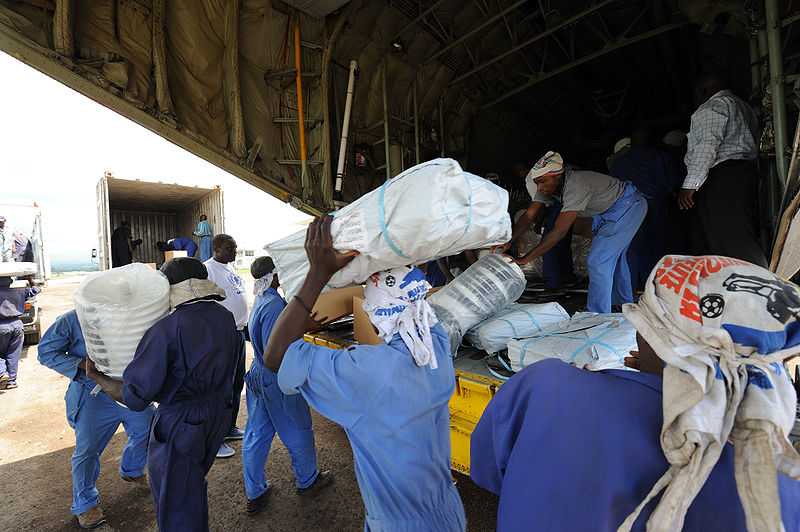Recommended
The world’s humanitarian aid architecture is growing outdated. Relief programs are most effective when they are integrated, locally owned, and demand driven. But humanitarian action in the 21st century remains constrained by a 20th-century aid model: siloed, supply driven, and centered on the individual mandates and sectors of major international aid agencies. This makes aid both less effective and less responsive than it could be. In a world where displacement is at the highest levels in generations, climate disasters are increasing, and humanitarian funding is beginning to level off, this disconnect is no longer tenable. But fixing it is not a simple matter—multiple rounds of humanitarian reform over the past 15 years have made progress but fallen short of fundamental change.
Earlier this summer in Geneva, CGD convened two high-level private roundtables, one with leaders from humanitarian donor institutions and another with senior executives from major humanitarian aid agencies (both multilaterals and NGOs), to discuss how to make humanitarian aid more cohesive and user-centered. The meetings were part of a multiyear research initiative exploring how modernizing the humanitarian business model and humanitarian governance are integral to improving field-level humanitarian impact. CGD teed up the conversation with three emerging ideas from our research (you can see the presentation slides here). These ideas—the subjects of several forthcoming papers CGD is developing —explore ways of better aligning aid delivery around enhanced impact toward affected people’s priorities:
-
Practical steps toward people-driven aid. The humanitarian sector has long affirmed that the people we serve must be at the center of response and have meaningful input on the decisions that affect their lives. Yet the power structures of humanitarian response are not driven by, nor accountable to, crisis-affected people. Living up to the aspiration of people-driven humanitarian action will require uncomfortable—but overdue—changes to the humanitarian system’s incentive structures and power dynamics (our policy proposals will be detailed in a paper to be released later this summer).
-
New financing models: Traditional donor practices tend to incentivize siloed programming rather than collective impact. As trends like multipurpose cash and joint needs assessments push the humanitarian system toward more integrated delivery, we need to rethink these fragmented funding practices. CGD outlined ideas for routing donor flows toward unified crisis-level humanitarian response plans rather than individual agency appeals; taking a longer-term time horizon on planning and costing in multiyear crises; and moving toward integrated multisector program platforms (mirroring the shift in cash programming toward unified, multipurpose cash transfers).
-
Area-based coordination: The existing cluster coordination system furnishes the building blocks of humanitarian program strategy, response planning, and (through cluster lead agencies) financing. This sector-based structure reinforces fragmentation and makes aid decision-making structures less accessible to local stakeholders. CGD presented emerging ideas on how area-based coordination models—which are geographically targeted, explicitly multisectoral, and engage the affected population through participatory design—could offset many of the shortcomings inherent in the cluster-based coordination model.
The roundtable participants shared important insights on the trajectory of humanitarian reform, the future of the aid system, and areas for potential change (the meetings were held under the Chatham House Rule, meaning that insights can be shared but not attributed). Several key takeaways emerged:
-
Power dynamics and shifting roles: Humanitarian leaders see the aid system today as more effective than it was a decade ago, but held back by inefficiencies and often out of step with the aspirations and capacities of aid recipients. Several argued that the incentive structures for aid groups are misaligned: one observed that agencies are rewarded more for individually “marketing their product” to their donors than for jointly improving it for their beneficiaries.
Moving towards a model that is more efficient and user-centric may require some of the largest and most powerful aid agencies to play different and more limited roles. This would be a significant shift from the aid model that has predominated for the last several decades, in which large multilateral agencies have accrued (with donor backing) end-to-end ownership over their mandates—including over standards, planning, resources, implementation, and evaluation. Instead, a new model may need to emerge, in which agencies’ end-to end responsibility for global mandates does not make them the default providers of all the functions and services under those mandates. The multilateral agency model of the future may evolve toward deeper and more equitable partnerships, rather than internalizing all functions into large one-stop-shop agencies. At the same time, participants cautioned that these kinds of changes must be approached judiciously to avoid disrupting or undermining the agencies’ essential normative roles and baseline delivery capacity.
Participants also acknowledged the importance of more inclusive power dynamics in the humanitarian sector. Some noted that many of the problems facing the sector—#AidToo scandals, failures to improve accountability to affected people, slow progress on localization— link back to entrenched power imbalances. The voices of affected people remain overlooked in decision-making, even as crises like DRC’s Ebola outbreak underscore the strategic and ethical importance of heeding community feedback. CGD’s forthcoming proposals for shifting greater influence to aid recipients sparked interesting reflections in both roundtables. Numerous leaders welcomed the proposal that aid feedback systems should function independently of aid providers, seeing these mechanisms’ credibility as closely interlinked with their independence. A proposal to increase Global South representation on NGO boards of directors, on the other hand, met with some skepticism, as participants feared their participation would be tokenistic rather than bring credible bottom-up perspectives into the governance process. -
Shifting views on financing: Donor allocations tend to flow to individual agencies rather than to specific crises, and many in the donor community have long viewed unearmarked core funding to these agencies as the most responsible way to provide humanitarian resources. However, several donors indicated growing disenchantment with this model, including an observation that if the traditional humanitarian business model is characterized by inherent fragmentation (as previous CGD research has argued), then routing highly flexible resources through individual agencies may reinforce this fragmentation. Unearmarked funding to aid agencies can also be difficult for donors to reconcile with political pressures at home—parliamentarians often want to know which crises their funds are supporting, not necessarily which agencies. There was also donor frustration with the practice of counting coverage of humanitarian appeals based on agency-specific projects rather than overall strategic needs—meaning that donor funds may be aligned with the response strategy but not officially “count” unless they go to the designated agency in the appeal.
Donors expressed considerable enthusiasm for developing alternate funding models. In particular, there was an appetite to move from pooling donor funding around individual agencies toward instead pooling more expansively around specific crises. There is an ongoing experiment along these lines in Yemen at the moment, due to a 2018 “block grant” contribution from Gulf donors that supports the broad humanitarian response plan rather than individual agencies. Donors showed interest in evolving existing Country-Based Pooled Funds (which tend to be small, gap-filling tools) toward a larger-scale “block grant” model. But they cautioned as well that this would require more consistent quality in Humanitarian Response Plans, as well as investments in leadership and fund administration. If tied to prioritized needs in the appeal, this might also enable a different approach to earmarking: donors could reduce or waive earmarking on the most urgent 25-50 percent of priority needs through the block grant fund, and earmark toward their own priorities only once that baseline level of support had been met. -
Area-based coordination—a complement, but not a replacement: Participants in the roundtables showed interest in expanding area-based coordination models (subject of a forthcoming CGD paper), and noted that these are already moving ahead in a few settings. But in both roundtables, participants cautioned that the existing coordination clusters should continue to play a prominent role. While the clusters have grown well beyond their initial scope, parts of their original rationale have proved sound. They have improved the quality and reliability of programming within their respective areas; as one participant noted, when the clusters launched in 2005, the problem was not fragmentation of services but outright absence: for example, having no one accountable for ensuring basic water services in a place like Darfur.
The challenge is to develop coordination models that can retain this progress while also addressing the clusters’ manifest shortcomings. Numerous aid leaders noted that the humanitarian system must do a better job of tailoring itself to differences in context: the coordination and programming requirements in protracted conflict and displacement crises are often very different from those in fast-onset natural disasters. And there was little pushback on the observation that the clusters have become a driver of fragmentation; by focusing primarily on quality of delivery within their respective sectors, they have inadvertently made alignment between them more difficult. The future of coordination may be something of a hybrid model: with clusters, but perhaps not a cluster “system.” Instead, a system that combines the centralized technical leadership, quality assurance, and last-resort accountability provided by the clusters, with the improved frontline program alignment, local engagement, and contextual specificity enabled by area-based coordination. -
Concern about donor practices: Aid group executives raised considerable concern that aid delivery is caught between a rock and a hard place by donor expectations on risk management. On the one hand, global crises are increasingly centered on places like Yemen, northern Syria, northeast Nigeria, or Sudan, where security threats are grave, aid diversion is a constant risk, and program monitoring must often flow through local proxies. Yet at the same time, aid groups perceive that donor risk tolerance is declining even as risks are increasing. Aid providers feel that donors expect increasing transparency from them but still immediately pull back at the first sign of a problem. Increasing transparency paired with decreasing risk tolerance is a recipe for leaving humanitarians unable to deliver in the most vulnerable places.
Aid groups also expressed frustration that while donors expect aid delivery to shift away from duplicative agency-owned systems and toward harmonized or shared approaches (core elements of the Grand Bargain launched in 2016), donors are not holding themselves to the same standard. Many donors continue to insist that partner agencies meet each donor’s own unique administrative requirements rather than bringing those requirements into alignment across donors. Agency audits were cited as an example—which agencies noted must be tailored to each donor’s particular specifications even though the content is materially the same. If agencies are expected to share common services, they questioned why donors could not apply the same approach and agree to accept a single consolidated audit. As donors explore options for country-level, rather than agency-level, pooling of funds, this issue of harmonized donor practices will become even more pressing. -
Governance and political will: Transformative change does not happen organically—it requires both political will and the political space in which to deliver on that will. The political will that produced the Grand Bargain in 2016 was widely seen as faltering—and the new “Eminent Person” leading the Grand Bargain process will have a big job to regenerate and sustain it. Both roundtables observed that the policy bandwidth of donors’ political leadership is diffused across so many fora—UN processes, agency governing boards, the Grand Bargain and other reform initiatives, etc.—that it can be hard to sustain high-level attention on macro-level reform priorities. Instead, most discussions tend to center around individual agencies or technical issues rather than overall impact and effectiveness. Ministerial-level engagement becomes proportionally more difficult to sustain as conversations head further into the weeds.
These issue point to a possible gap in global humanitarian governance: the absence of a forum where the sector’s funders, partners, and (ideally) recipients convene at a high level to set policy, review priorities and reforms, and sustain political engagement on global humanitarian effectiveness. The lack of progress on challenges like risk-sharing is a reflection of this dynamic; it is an issue that cuts across the interests and policies of numerous donors and aid groups, but cannot be addressed adequately in any of the fora that currently exist.
Rights & Permissions
You may use and disseminate CGD’s publications under these conditions.






